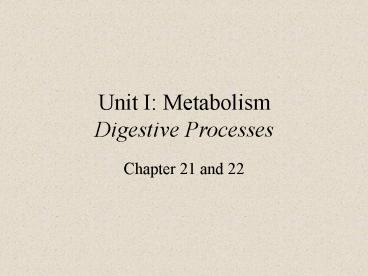Digestive Processes PowerPoint PPT Presentation
1 / 21
Title: Digestive Processes
1
Unit I Metabolism Digestive Processes
Chapter 21 and 22
2
Mastication or Chewing
- ? surface area exposed to digestive enzymes
- Contact of food with sensory receptors triggers
chewing reflex - tongue, buccinator and orbicularis oris
manipulate food - masseter and temporalis elevate the teeth to
crush food - medial and lateral pterygoids swing teeth in
side-to-side grinding action of molars
3
Salivation
- Total of 1 to 1.5 L of saliva per day
- Cells filter water from blood and add other
substances - Food stimulates receptors that signal salivatory
nuclei in medulla and pons - parasympathetic stimulation ? salivary glands
produce thin saliva, rich in enzymes - sympathetic stimulation ? produce less abundant,
thicker saliva, with more mucus
4
Swallowing / Deglutition
5
Swallowing / Deglutition
- Typical bolus 9 seconds
- Liquids 2 seconds
- A dry or poorly lubricated bolus may need
secondary peristaltic waves
Peristalsis allows us to move a bolus regardless
of our body position.
6
Gastric Motility
- Swallowing center signals stomach to relax
- Receptive-relaxation response
- Peristalsis
- contraction every 20 seconds
- stronger contractions after 30 minutes ejects 3
ml - typical meal emptied from stomach in 4 hours
7
Vomiting
- Induced by
- excessive stretching of stomach, psychological
stimuli or chemical irritants (bacterial toxins) - Emetic center in medulla causes
- retching
- Lower esophageal sphincter to relax
- stomach and duodenum to contract spasmodically
- vomiting
- when abdominal contraction forces upper
esophageal sphincter to open
8
Regulation of Gastric Secretion
1. Cephalic Phase
2. Gastric Phase
- See, smell, taste, or think of food.
- Directed by the CNS
- Prepares the stomach to receive food
- Production of gastric juice accelerates
- reaching rates of about 500 mL/h
- lasts only minutes.
- Arrival of food in the stomach
- (1) distension of the stomach
- (2) an increase in the pH
- (3) the presence of undigested proteins
- Lasts 3-4 hours
- Gastrin stimulates contractions in the
- muscularis externa of the stomach.
Mucous cells
Chief cells
Parietal cells
Chief cells
G cells
Parietal cells
G cells
9
Regulation of Gastric Secretion
3. Intestinal Phase
- Chyme first enters the small intestine
- Function control the rate of gastric emptying
- Enterogastric reflex
- Stimuli? stimulation of stretch receptors in
stomach and - ?stimulation of stretch
- receptors in intestine
- Purpose Inhibit gastric activity
- Stimulates contraction of
- pyloric sphincter
- Mucus production
10
Intestinal Hormones
- Cholecystokinin (CCK)
- Contraction of gallbladder
- Secretions of pancreatic enzymes
- Relaxation of hepatopancreatic sphincter
- Secretin
- Glucose dependent insulin peptide/ Gastric
inhibitory peptide - Overall effect reduce gastrin secretion and
passage of chyme
11
Small Intestine Motility
- Segmentation -
- stationary ring-like constrictions
- not as in peristalsis
- Purpose
- mix
- churn
- Pacemaker cells in Muscularis externa
- Provides the most contact digestion
http//youtu.be/PfnKvErPwY4
12
Carbohydrate Digestion
- Salivary amylase ? oligosaccharide
- 50 of dietary starch digested before it reaches
small intestine - Pancreatic amylase ? oligosaccharide and maltose
- Brush border enzymes ? monosaccharides
13
Carbohydrate Absorption
- 80 of glucose taken up by Na-glucose transport
proteins ? - Facilitated diffusion ? blood capillaries of
villus ? - Delivered to liver
14
Protein Digestion
15
Protein Absorption
- Behaves like monosaccharides
- Taken up by Na-dependent transport proteins ?
epithelial cells ? - Facilitated diffusion ? blood capillaries of
villus ? bloodstream
16
Lipid Digestion
- Lipase Lingual lipase, gastric lipase
Bile
2.
3.
17
Lipid Absorption
1.
2.
18
Nucleic Acids, Vitamins, and Minerals
- Nucleases
- brush border split them completely apart
- Vitamins are absorbed unchanged
- A, D3, E and K with other lipids
- B complex and C by simple diffusion
- B12 if bound to intrinsic factor
- Minerals are absorbed all along small intestine
- Na cotransported with sugars and amino acids
- Cl- exchanged for bicarbonate reversing stomach
- Iron and calcium absorbed as needed
19
Water Balance
- Digestive tract receives about 9 L of water/day
- 0.7 L in food, 1.6 L in drink, 6.7 L in
secretions - 8 L is absorbed by small intestine and 0.8 L by
large intestine - Diarrhea
- feces pass through too quickly if irritated
- feces contains high concentrations of a solute
(lactose)
20
Absorption and Motility of Large Intestine
- Transit time is 12 to 24 hours
- reabsorbs water and electrolytes
- Haustral contractions occur every 30 minutes
- distension of a haustrum stimulates it to
contract - Mass movements occur 1 to 3 times a day
- filling of the stomach and duodenum
21
Defecation
External sphincter can be voluntarily relaxed

